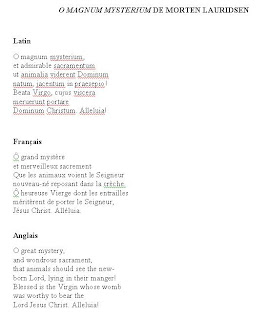The Magnificat by Arvo Pärt  The Magnificat by Arvo Pärt
The Magnificat by Arvo Pärt (pronounced "Loss")
Soprano 1 (including the solo)
Soprano 2 Alto Tenor (1 and 2) Low Born in Estonia in 1935, Pärt studied music at the Tallinn Conservatory under the tutelage of Heino Eller (a composer, an avid "estonicité of" having studied in St. Petersburg and taught many composers of the Baltic states). As Estonia is from 1940, under the influence of the Soviet regime, he has little access to Western music, but managed to hear some works by Boulez, Webern and Nono. During the '60s, when the state releases its grip a little, went to investigate the twelve-tone, serialism and aleatoric music. It is part of a group of students who flout aesthetic standards Socialists (1
). He is considered a radical by the authorities. His Credo (1968) is banned. It alternates between periods of creative and contemplative silence. It enjoys one of the breaks, to study the works of Machaut, Ockeghem, Obrecht, Josquin Desprez. During the '70s, he lingers in plainsong. He is interested in bells, the bells above, and their resonance. He developed a new way to compose and adopt the technique of tintinnabulist which is based on the resonance of bells (which sound more persistent contains notes at once), the triad and inversions of chords. He returned to tonal music. In 1980, he left Estonia in Vienna and Berlin. He composed his Magnificat in 1989. The room is registered for the first time, with the Estonian Philharmonic Chamber Choir with the Tallinn church Niguliste and distributed by ECM Records in 1993.
It is also noteworthy that Pärt is a strong religious and is part of the Orthodox Church and tradition hésichaste (aware of inner peace, tranquility, imperturbability). The compositional techniques he has adopted are a means for him to express his deep spirituality, communicating with the religious sentiment. He compares his music to white light (which is the sum of all colors) and the prism, intelligence, sensitivity of the listener. For him, silence is as expressive as the notes themselves. (
2) Music critics have often associated with the Polish composer Gorecki (author's Symphony No. 3) calling them "mystical minimalist". In his book "Thresholds: Rethinking Spirituality Through Music" (
3) Marcel Cobussen explains the resurgence of spirituality in music by a disenchantment with modernity, the commodification of culture. He said the new spiritual music is presented as a farewell to modernity but also to modern music or avant-garde. It goes further by stating that the composer is bringing to the listener what religion can do.
were also grouped with Pärt and Gorecki, Sofia Gubaidulina, Giya Kancheli, Andrzej Panufnik because of their independence (relative modernity of the twentieth century), their mutual respect and similarity of their style. (4
)
(I wrote this text for my class at U of M) A biography (in English) is available here
. In 2006, the American Public Radio (NPR) devoted an issue to
Estonian composer and where you can hear the Magnificat sung by a choir of Estonia. (Click on "Hear the performance).
are the lyrics and translation (click to enlarge)

 A short review of the work
A short review of the work The Magnificat Arvo Pärt is distinguished by its delicate simplicity and introversion. By an assemblage of long values, a slow and meditative, and his writing parallel, the work refers to Gregorian chant. Unlike many of the Magnificat Baroque and Renaissance, Pärt does not seem concerned about putting words to music: the verses are distributed without regard to the meaning conveyed by the verse, between soloist (accompanied by another voice) - articulating text in a monotone - and the rest of the choir, usually consisting of three voices (sometimes six doubles when another console). Highlights (on "generatione" and "Et misericordia ejus a Progenie in progenies timentibus") occur at times rather unexpected, since unrelated word meanings.
Pärt uses an old technique, that of the drone, but reversed (because the role is given to the shrill rather than bass). The deep voice, by contrast, often inherited from the main melody. The notes sung by the chorus of voices raised or lowered, based around the pivot note (the C of the soprano). Sometimes, this results in friction (for example, with the sopranos re II, the first action) that gives the piece a sense of mystery. These effects are the result of a new compositional technique he developed during the 70s: the art of tintinnabulist.
may also notice two passages on hiccups "Disperse superbos" and on "and divites dimis inane" which are often used preceded by the composer of the Ars Nova (XIV century) and Pärt has studied.
Magnificat Composer closes with a return to introspection he expresses a pianissimo and a slowing effect (obtained with values very long), a treatment that does not reflect the words "My soul magnifies the Lord" ...
Suggestion
 Summa is another beautiful piece of choral Pärt. The pace a bit faster than that of the Magnificat reminds me of flocks of church bells.
Summa is another beautiful piece of choral Pärt. The pace a bit faster than that of the Magnificat reminds me of flocks of church bells.
I suggest you listen a version performed by the Early Music Studio of Montreal label Atma .











